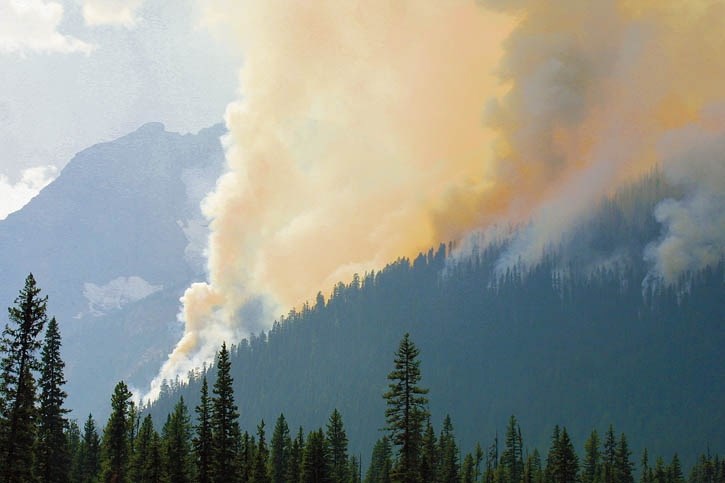A massive wildfire swept a destructive path through Kootenay National Park in 2003, but 10 years after the fire, there are signs of new life and growth in the blackened area.
The Tokumm-Verendrye fire came dangerously close to burning down historic Kootenay Park Lodge, closed Highway 93 South for several days and had the potential of making it to the Bow Valley and taking a run at the Town of Banff less than 50 kilometres away.
Having burned almost 18,000 hectares, today the burn area has transformed into a lush and productive landscape that’s home to countless wildflowers and provides critical habitat for animals like bears and moose.
Rick Kubian, who is now Parks Canada’s resource conversation manager for Lake Louise, Yoho and Kootenay, was the fire incident commander at the time of the devastating fire season.
“Those are 40 days that I will remember for the rest of my life,” said Kubian of the fire, dubbed by Parks Canada personnel as the “Holy Sh..” fire.
“At the time, I remember standing there and watching and thinking, this is the fire of a career.”
The 2003 fire season was one of the most catastrophic in British Columbia’s recorded history. Due to an extended drought in the southern half of the province, forest firefighters faced conditions never seen before in Canada.
Lightning strikes, human carelessness and arson all contributed to almost 2,500 fires involving more than 10,000 firefighters and support personnel, and burning more than 265,000 hectares.
The hardest hit areas were Naramata and Kelowna, where the 25,600-ha Okanagan Park Mountain blaze caused the evacuation of 33,050 people and the loss or damage of 238 homes. The McLure-Barriere-Louis Creek fire destroyed 72 homes and nine businesses.
After an uncharacteristically dry June with little rain in the mountains here, Banff and Kootenay national parks endured 42 straight days of no rain and hot temperatures. It was the perfect storm for a fiery summer.
On the evening of July 31, lightning started five small fires in the northern end of Kootenay National Park and the nearby Taylor Lake area of Banff National Park.
Parks Canada was quick to put out three of the fires, including two near Taylor Lake that posed the greatest threat to the Banff townsite. Two of the fires eventually merged to form the Tokumm-Verendrye blaze.
What started as two small fires quickly escalated into a 40-day battle, burning 12.5 per cent of Kootenay National Park. More than 160 people were fighting the fire.
The fire, thick smoke and tinder dry conditions throughout Banff and Kootenay forced unprecedented closures of trails, campgrounds and day-use areas. Shadow Lake Lodge, a backcountry retreat in Banff, was evacuated as a precautionary measure.
The out-of-control wildfire came within 50 metres of the historic Kootenay Park Lodge property, which includes the historic 1923 lodge, 10 log cabins and new information centre.
Parks fire crews were able to draw the blaze away from the wooden lodge in two directions by using helicopters to ignite the surrounding forest from the air.
All buildings on the property were also coated with a special fire retardant foam, and a sprinkler system saturated the property as the blaze moved dangerously close.
Lodge owner Paul Holscher was ordered to leave on Aug. 3, but refused to do so to save the property. He loaded paperwork and important documents into his truck in case he was later forced to leave.
However, Holscher did get his staff to safety in Radium, where he put them up in a hotel until Parks Canada allowed them back to the lodge on Aug. 28.
Holscher said he went through all emotions – initial excitement quickly turned to concern as the fire started advancing on his lodge, and finally frustration as he realized the business season was lost.
“It happened pretty quickly and when the fire started moving toward me and Parks was basically letting it go, I started getting concerned,” he said. “I could smell it, I could hear it, I could feel the heat of it, and I realized it was more of a safety issue than I first thought.”
Holscher had survived a fire two years earlier when the August 2001 Mount Shanks fire grew from 600 hectares to 2,400 hectares in just two-and-a-half hours, ripping six kms up the valley and forcing the evacuation of the lodge.
“I must have a guardian angel looking over me because I’ve dodged a few bullets and hopefully a few more,” he said.
The two fires have certainly made Holscher realize he’s in a fire zone. In fact, Kootenay National Park records the second-most lightning-sparked fires in all of Canada’s national parks, behind only Wood Buffalo.
“I am much more aware of danger, and I’ve come to the realization that there is a possibility this place could burn down. I’m mentally prepared for that,” he said, noting there’s a permanent firebase at Kootenay Crossing.
“I didn’t realize this when I bought the place, but I am located in Lightning Alley and fire is very much a part of this park. Nearly every year there’s a fire. Some are big, some are small.”
Holscher said there has been ongoing interest from visitors to the lodge about what happened to the surrounding forest, with many querying if mountain pine beetle destroyed the forest.
“Some people may see the whole landscape as really ugly, but I just say you have to look a little deeper and with different lenses. The beauty is different,” he said.
“There’s a lot of beauty there and I think some people miss that. You look at a big forest and see black, but if you look between the trees, there’s six foot high fireweed and a lot more animal life now than before.”




